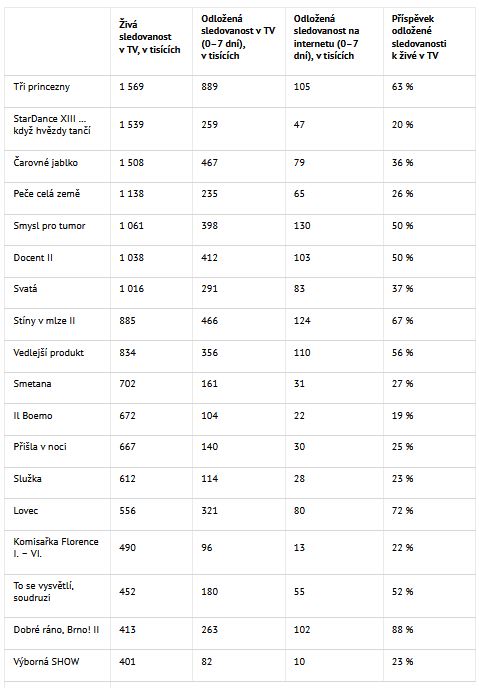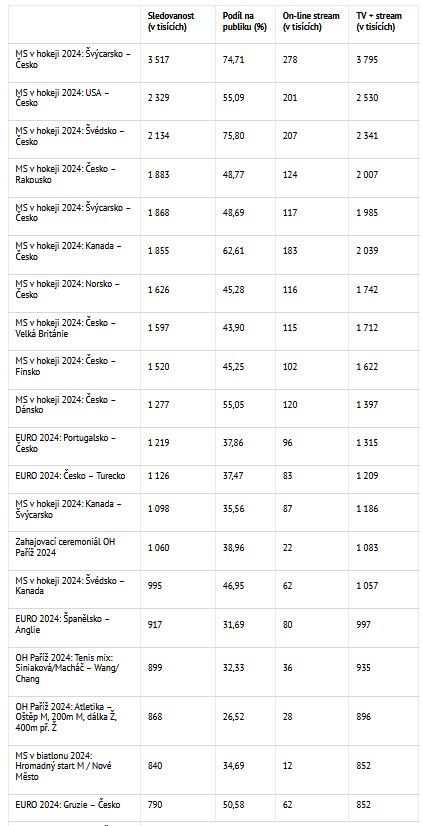Most TV viewers watch shows in real time. But electronic viewership data shows that the proportion of delayed viewing has been rising in recent years. So-called delayed viewing includes all viewers who watch a programme minutes or even days after it has aired. For example, because they were doing something else at the original time of broadcast or because of a confluence of programmes they preferred another station.
Time-shifted viewing is typically enabled by pay-TV service providers and TV apps. For example, you can go back to a specific day in the programme guide, select a programme and start it. The time when programmes are available can vary from operator to operator, but they are usually available in their archives a week in advance. Another popular option for backwards viewing is the online video libraries of individual stations.
According to data from the Association of Television Organisations for the entire Czech television market, in 2024, delayed viewing within three days of broadcast accounted for 11.1% of total viewing. Some programmes are gaining tens to hundreds of thousands of additional viewers as a result, especially series, films and documentary cycles. News programmes or sports, on the other hand, are watched predominantly in real time.
Czech Television, for example, discusses deferred viewing in detail in its annual report for last year. "In 2024, of the total time viewers spent with Czech Television, 87.4% was spent watching live on TV, 8.6% was spent watching deferred TV and 4% was spent watching via the internet, either live or from the archive," the document states.
For example, for last spring's series Smysl pro tumor, an average of 398,000 viewers with smart TVs delayed viewing individual episodes. Another 130,000 viewers watched them via the Czech Television's internet archive. In total, the delayed viewing added 50% more viewers to the classic viewership.
The second series of Stíny v mlze was also very successful on the internet, with 124,000 viewers watching the individual episodes on iVysílání and another 466,000 viewers watching them on delayed viewing (+67% of live viewership). Other successful titles were the miniseries Vedlejší produkt (110 thousand viewers online) and Docent II (103 thousand).
The second season of the successful comedy series Dobré ráno, Brno! was watched by 102 thousand users on the Internet and another 263 thousand users watched it on TV. The total addition to the live viewership was a record 88%.
In absolute numbers, the Christmas Eve fairy tale Tři princezny had the highest deferred viewership. 889,000 viewers delayed watching it on TV and a further 105,000 watched it online. The total TV audience was 2.4 million viewers over the age of four.
However, the story, in which Princesses Sophie, Leona and Flora embark on an adventurous journey to save the kingdom from the dark threat of Queen Mortana, did not go down well with viewers. It earned a low rating of 27% on the largest Czech film database, ČSFD, and Czech Television itself acknowledges in its annual report that the fairy tale produced by the Ostrava studio "unfortunately was not well rated".
 Source: ATO-Nielsen, PEM D, data for the target audience over 4 years old
Source: ATO-Nielsen, PEM D, data for the target audience over 4 years oldOf the cycles broadcast on CT2, Stezka Českem showed the highest deferred viewership. The journey of actor Mirek Vladyka along a long-distance hiking trail from the westernmost point of the country to the easternmost one was additionally watched by 108,000 people on TV and 27,000 on the Internet.
The second series of the series Příběhy starých hospod also attracted 111 thousand additional viewers on TV and 19 thousand more on the Internet. The documentary The Body in My Head on the subject of bodyshaming also attracted viewers (49,000 on TV; 16,000 on the internet).
The audience of the cultural programme ČT Art sought out the recording of the theatre production Tři grácie z umakartu on TV and on the Internet, where live viewership (124,000) increased by 48% thanks to delayed viewing. The documentary Cimrmani zblízka was also successful (97,000 live) with a 64% increase in viewership.
Among CT24 programmes, viewers mostly rewatched the New Year's speech of the President of the Republic Petr Pavel on 1 January 2024 (35 thousand viewers) and Hyde Park Civilizace on 9 March 2024 with the theme of life in North Korea (11 thousand viewers).
Overall, Czech Television aired 54 of the most watched programmes of last year across the entire television market. The success of Czech hockey players at the World Championships contributed to this. The most watched programme of the year was the final match between the Czech Republic and Switzerland, which was watched by a total of 3.74 million viewers over the age of four on TV or online.
The match became the most watched match on CT Sport in its history and the most watched match on all TV channels from December 2022.
Most watched sports broadcasts of 2024
 Source: ATO-Nielsen, CT, target audience aged four and over
Source: ATO-Nielsen, CT, target audience aged four and overSource: lupa.cz

